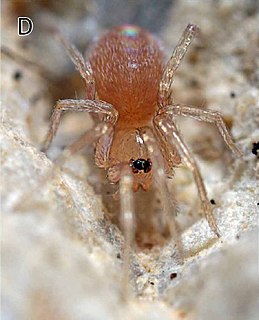
The sac spiders of the family Clubionidae have a very confusing taxonomic history. Once, this family was a large catch-all taxon for a disparate collection of spiders, similar only in that they had eight eyes arranged in two rows and conical anterior spinnerets that touched, and were wandering predators that built silken retreats, or sacs, usually on plant terminals, between leaves, under bark, or under rocks. These are now recognized to include several families, some of which are more closely related to the three-clawed spiders, like lynx and wolf spiders, than to Clubionidae and related families.

Oonopidae, also known as goblin spiders, is a family of spiders consisting of over 1,600 described species in about 113 genera worldwide, with total species diversity estimated at 2000 to 2500 species. The type genus of the family is OonopsKeyserling, 1835.

Ant spiders are members of the family Zodariidae. They are small to medium-sized eight-eyed spiders found in all tropical and subtropical regions of South America, Africa, Madagascar, Australia-New Guinea, New Zealand, Arabia and the Indian subcontinent. Most species are daytime hunters and live together with ants, mimicking their behavior and sometimes even their chemical traits. Although little is known about most zodariids, members of the genus Zodarion apparently feed only on ants; a number of other genera in the family are apparently also ant specialists.
Tenedos is a spider genus of the family Zodariidae. It has around 45 species from Central and South America.

Ochyroceratidae is a six-eyed spider family, with 165 described species in ten genera. They are common inhabitants of caves and the tropical forest litter of South Africa, the Caribbean, Asia and South America. Considered an ecological counterpart of the Linyphiidae of the northern temperate zone, species are especially diverse in the Indo-Pacific region.
Arabellata is a genus of South Pacific sac spiders first described by V. Versteirt, L. Baert & Rudy Jocqué in 2010. As of April 2019 it contains only two species, both found in Papua New Guinea.
Invexillata is a genus of South Pacific sac spiders first described by V. Versteirt, L. Baert & Rudy Jocqué in 2010. As of April 2019 it contains only three species, all found in Papua New Guinea.
Arushina is a monotypic genus of East African corinnid sac spiders containing the single species, Arushina dentichelis. It was first described by Lodovico di Caporiacco in 1947, and has only been found in Tanzania. Originally placed with the Dictynidae, it was moved to the Ant spiders in 1967, to the Sac spiders in 1991, then to the Corrinid sac spiders in 2000.

Australutica is a genus of spiders in the family Zodariidae. It was first described in 1995 by Jocqué. As of 2017, it contains 6 species.
Cavasteron is a genus of spiders in the family Zodariidae. It was first described in 2000 by Baehr & Jocqué. As of 2017, it contains 12 species, all from Australia.
Cydrela is a genus of spiders in the family Zodariidae. It was first described in 1873 by Thorell. As of 2017, it contains 19 species from a variety of places in Asia and Africa.
Dusmadiores is a genus of spiders in the family Zodariidae. It was first described in 1987 by Jocqué. As of 2017, it contains 6 species.
Epicratinus is a genus of spiders in the family Zodariidae. It was first described in 2005 by Jocqué & Baert. As of 2017, it contains 5 species.
Euryeidon is a genus of spiders in the family Zodariidae. It was first described in 2004 by Dankittipakul & Jocqué. As of 2017, it contains 6 species, all from Thailand.
Heradida is a genus of spiders in the family Zodariidae. It was first described in 1893 by Simon. As of 2017, it contains 7 African species.

Ishania is a genus of Central American ant spiders first described in 1925 by Ralph Vary Chamberlin. Originally placed in Agelenidae, it was later moved to Zodariidae in 1965.
Neostorena is a genus of spiders in the family Zodariidae. It was first described in 1914 by Rainbow. As of 2017, it contains 7 species from Australia.

Psammorygma is a genus of African ant spiders found in the deserts of southern Africa, namely the Kalahari desert and the Namib desert. They are somewhat larger spiders, growing up to twenty millimeters in length. The carapace and chelicerae are brightly colored, while the legs and abdomen are generally a darker black or gray. They can be distinguished from other genera by a knob-like proximal extension found on the cheliceral fang and a double row of dorsal spines in a specific location. First described in 1991 by Jocqué, the name is from the Greek psammon, meaning "sand", and orugma, meaning "mine", in reference to the sandy tunnels these spiders live in. As of February 2019, it contains only three species: P. aculeatum, P. caligatum, and P. rutilans.
Tropizodium is a genus of spiders in the family Zodariidae. It was first described in 2005 by Jocqué & Churchill. As of 2017, it contains 9 species.
Nosterella is a genus of spiders in the family Zodariidae. It was first described in 2017 by Baehr & Jocqué. As of 2017, it contains 6 Australian species.






